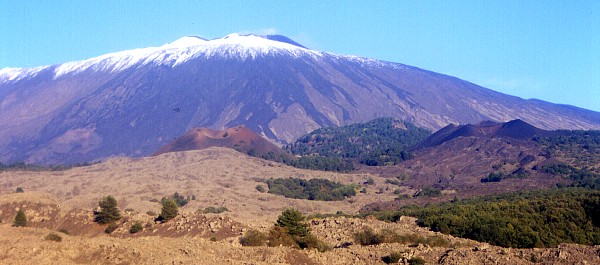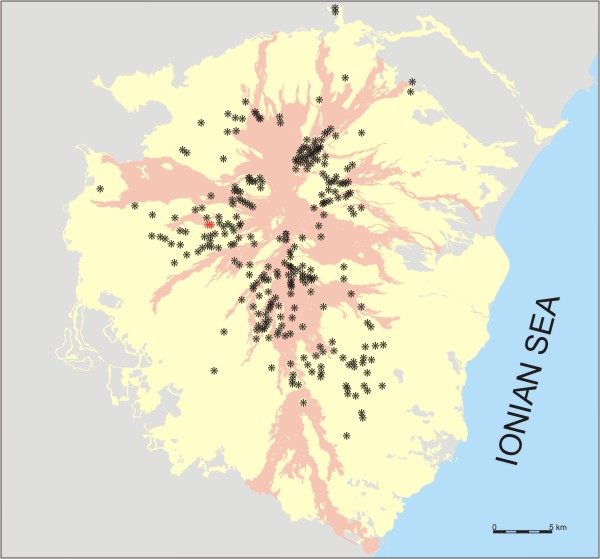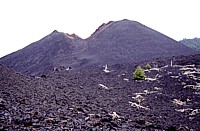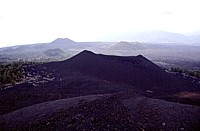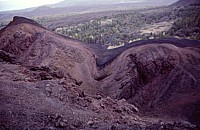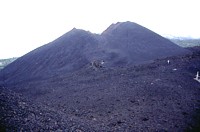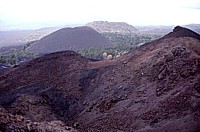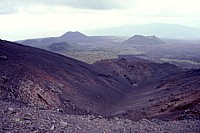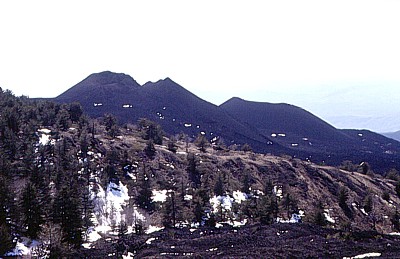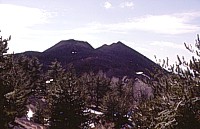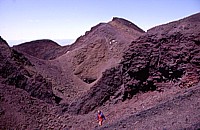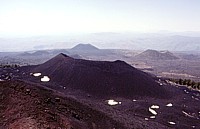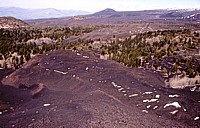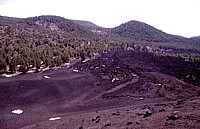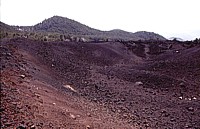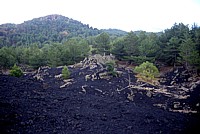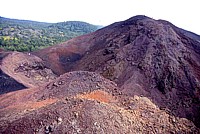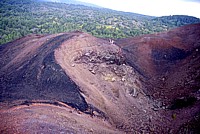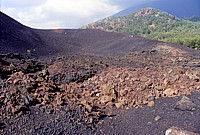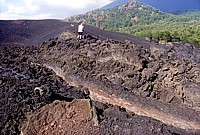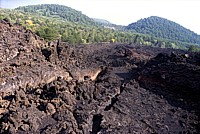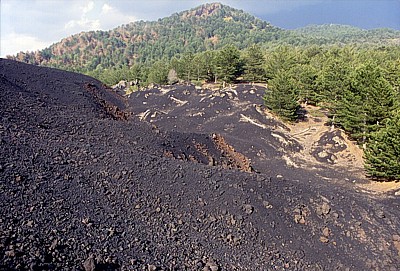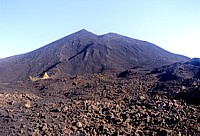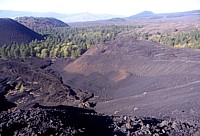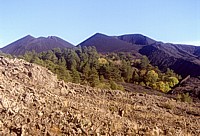| Etna
index |
||
| Geology | Geological history | Cones and craters |
| Eruptive characteristics | Eruptions before 1971 | Eruptions since 1971 |
| Etna and Man | References | Web sites |
| Weather forecasts | FAQ | Latest news |
Panoramic
view of the western flank of Etna in mid-October 2002 (less than
ten days before the volcano erupted violently from its southern
and northeastern flanks), showing the dark cones of the Monti
De Fiore and their lavas at right. The upper of the cones, Monte
De Fiore I, is largely covered by Monte De Fiore II. The forest-clad
cone behind them to the left is Monte Rosso, and still further
to the left rises the reddish-oxidized cone of Monte Nuovo, formed
in 1763. The light-colored lava field in the left foreground is
of that same eruption. Dark lava flows on the flank of the main
volcanic edifice, in the background, were erupted from the Bocca
Nuova, whose snow-free flank is seen on the right side of the
otherwise snow-covered summit area, in October-November 1999 |
Mamma
Etna's countless children
Monti De Fiore (1974 eruption)
W flank, 15.92700° E, 37.74260° N (M. De Fiore I)
summit elevation: 1735 m (M. De Fiore I)
and 1689 m (M. De Fiore II
![]()
|
|
Location
of the Monti De Fiore (red asterisks). Black asterisks are other
flank craters and cones of Etna. Lavas erupted since 1600 are shown
in pink; extent of Etnean volcanics in light yellow. |
The
two Monti De Fiore formed during the relatively small but, in many respects,
unusual January-March 1974 eruption on the
west flank, which represents the sole example of an eccentric eruption
during the 20th century. They lie in a densely forested area at about
1650 m elevation and rise 40 and 70 m above the surrounding terrain, respectively.
The larger of the cones formed during the first phase of the eruption,
with explosive activity occurring at several vents at the summit of the
cone, while lava issued from several vents on the flanks and at the base
of the cone. In one case, the flank of the cone bulged before lava began
to issue from the lower portion of the bulge; in another, a collapse pit
formed above a newly forming effusive vent. Effusive vents at the southeastern
and southern base of the cone lie in small depressions. On the north side
of the cone, an unusually thick lava flow extends about 350 m from its
source, a shallo saucer-shaped depression in the north flank of the cone.
The most peculiar feature related to extrusive activity at this cone is
a steep-sided "collar" of blocky lava (mostly covered by pyroclastics
produced by explosive activity that occurred at the same time) which surrounds
the eastern side of the cone and in places is more than 10 m high. This
lava apparently oozed through the base of the growing cone rather than
flowing through a breach in the crater rim.
The second cone formed in March 1974, following 3 weeks of quiet, and
shows a much simpler morphology, both of the cone and its single effusive
vent. The cone is horseshoe-shaped and open to the west; the effusive
vent lies on the western side of the crater.
I visited and climbed the Monti De Fiore first in May 1996 and at least
ten times since then, often accompanying groups of scientists and students.
The site is very spectacular and generally very quiet since it lies far
away from the main tourist routes. In fact, very few tourists ever find
their way to the Monti De Fiore, firstly because they cannot be reached
by car (the nearest parking area is more than 4 km away, near Monte Intraleo),
and secondly because there is only one single decent footpath leading
there, and you have to know exactly where it is.
The photographs on this page were taken during many different visits;
only the earliest of these have been previously available on this site
but have been re-scanned since the former versions were of extremely poor
quality (the original slides are very dark).
Images of 12 May 1996
Images of 17 April 1997
Panoramic
view of the western flank of Etna in mid-October 2002 (less than
ten days before the volcano erupted violently from its southern
and northeastern flanks), showing the dark cones of the Monti
De Fiore and their lavas at right. The upper of the cones, Monte
De Fiore I, is largely covered by Monte De Fiore II. The forest-clad
cone behind them to the left is Monte Rosso, and still further
to the left rises the reddish-oxidized cone of Monte Nuovo, formed
in 1763. The light-colored lava field in the left foreground is
of that same eruption. Dark lava flows on the flank of the main
volcanic edifice, in the background, were erupted from the Bocca
Nuova, whose snow-free flank is seen on the right side of the
otherwise snow-covered summit area, in October-November 1999 |
Images of late June 1999
This
photograph shows the steep outer margin of the peculiar lava "collar"
surrounding the eastern base of Monte De Fiore I and forming a
near-vertical scarp up to 10 m high. Monte Rosso is in the background |
Images of mid-October 2002
Copyright © Boris Behncke, "Italy's Volcanoes: The Cradle of Volcanology"
Page set up on 14 December 2003

